There is No Tomorrow...
Reading Aloud Not One, But Two Essays by The Eminent John Michael Greer!
A sunless horizon, where shadows stretch endlessly across a crumbling megacity engulfed in perpetual twilight. Collapsed buildings lean over shattered streets, where silence reigns and the remains of forgotten lives decay. A lone figure stands against the desolation, staring into the void as storm clouds churn overhead. The atmosphere is heavy with hopelessness and despair, capturing a world where time has ceased to exist, and there is no tomorrow. Dark, atmospheric, and surreal, evoking a post-apocalyptic sense of finality.
A lot can be said about the Troubled Times we live in presently:
Your Friendly Neighbourhood DOOM Merchant has spent these past few weeks conversing with the wonderful Sir & an incredible roster of Good Sirs on the ‘When East Meets West’ podcast. We have gleaned a few ‘common threads’ when doing so.
First, during our sitdown with the eminent Sir Cleveland Blakemore (i.e. ) some weeks ago, we concluded that things will only get worse soon & many of the Romantic dreams people have had about the future will soon be thrown into the Dustbin of History.
In the next episode, where the three of us were joined by the Eminent Mister , we continued our DOOM-ful prognostications of all the various ways in which Industrial Society, writ large, & the Western world, in particular, was circling the drain.
The Eminent Sir (writing ) joined us to speak about The Company & the Myriad ways in which they garner & seize Power & Influence to prepare for the coming DOOM, gloom & despair in the West & worldwide.
Sir (writing ) joined Yours Truly & Sir & Sir Cleveland ( i.e. ) for an in-depth episode where we covered the Future of Industrial Society, the West & the overall trajectory of things moving forward.
At the start of the episode, Sir Cleveland also laid out valuable ‘big picture’ info for those private individuals willing, ready & able to get off their posteriors & ‘actually do something about’ the DOOM, gloom & despair we presently find ourselves in.
Afterward, we did a shorter episode with Sir ( writing ) to focus primarily on the British situation, focusing on the Riots & Looting of recent days & weeks.
This was followed by another extensive sitdown with Sir Cleveland to touch upon Survivalism basics, & how to garner food, water, shelter & other necessities in many disaster scenarios.
Dr. (writing ) joined us for the next episode to speak at length about Why Project Eurabia is a net boon for the Falling West, & how a Re-enchantment of the World around us is vital to keeping society & Civilization, writ large, intact.
Finally, just days ago, we finished a Blockbuster sitdown with Sirs & to speak about Degrowth, Revitalization, Repriotization, Ecotechnics & Retrotopia. We also touched upon the dangers of Technophilia:
Notably, we all went over the myriad ways in which worship of Progress, Technology, Space Travel & other kinks of the Secular, Modernist religion of the era has blinded Modern Man from his most fundamental troubles & predicaments.
If you have not done so already, Please Subscribe to all of the Eminent Sirs I mentioned earlier, Dear Readers & Listeners! Yours Truly will link them all below!
The Eminent Sir John Michael Greer does not write on SubStack; however, his writings can be found elsewhere in Cyberspace:
Ecosophia.net (Official Blog)
Sir Kenaz Filan’s Fantastic Stack duo:
Sir Cleveland (i.e. Texas Arcane) & his Exceptional Stack:
Mister ’s Eminent Stack:
Sir ’s Epic Stack:
Sir Phisto Sobanii’s Wonderful Stack:
Sir ’s Terrific Stack:
Dr. ’s Extraordinary Stack:
Sir Uncouth Barbarian’s Lovely Stack duo:
Sir ’s Magnificent Stack:
Over several hours of listening, speaking ( & learning! ), Yours Truly was reminded of The Eminent Sir ( Grandmaster of DOOM extraordinaire ) & his writings over the past several years outlining the Long Descent of Industrial Society in the West & beyond.
Mainly, I was reminded of an Essay Duo the Grandmaster Penned over two years ago on two related topics, namely (1) The loss of a meaningful vision of the Future & (2) The impotence of Industrial society in dealing with the coming, self-inflicted Catastrophes.
For the former, we see in ‘How we lost the future: Our fantasies are banal reflections of past glories’ how the Secular religion of Progress, Technophilia, Space Traversal & related derivatives has all but exhausted itself in the past few decades.
Gone are the days when the Future was something authentic & awe-inspiring, able to rally around people from across the Western world & provide the broader society benchmarks & standards to dream toward. Instead, what remains today are facile plaigarisms:
The ‘Futures of Today’ are rehashed narratives from decades ago (some even from a few centuries back! ). All they do is harken to an epoch that not only no longer exists but is fast being thrown wholesale into the Dustbin of History, soon to be forgotten entirely.
As for the latter, we see in ‘We are the authors of our decline: It's too late to avoid a difficult future’ a seamless continuation from the former:
Since the Grand Narratives of Progress, Technophilia, Space Traversal & related derivatives have failed, the world we have built upon the notion of Infinite Growth, Conspicuous Consumption & related evils is all but DOOM-ed in the coming years.
The DOOM-sayers of the past were reviled, ridiculed & lampooned viciously, only for things to have gotten much more awful & far less salvageable. No longer can there be a ‘soft landing,’ given how rapidly the Car is still driving off toward the Cliff…
What does in both essays (when they are examined in conjunction) is demonstrate that the maneuvering room for meaningful mitigation of damage is long gone.
Some degree of amelioration can still be achieved. However, it would involve the Car going off the cliff, its passengers gritting their teeth, and taking a Brutal Hit.
In doing so, Humanity will find that for the rest of the 21st Century CE; sundry crises will abound worldwide, yielding War, Famine, Pestilence, & Death that will make the post-World War Peace we have all enjoyed thus far… feel like an Idyllic Earthly Paradise.
Yours Truly often says over here that The DOOM Cometh…!
For Grandmaster of DOOM , DOOM is in the air we breathe in, the water we drink & the food we dine in… for that is the Long Descent we find ourselves at, with the Golden Age of Fossil Fuels ending & heralding a New Dark Age…
The essays are linked above at UnHerd.com for those wishing to read them there instead!
Here is another alternate link to the original First Essay.
& Here is another alternate link to the original Second Essay.
Without further adieu, here is the full text of the Essay Duo mentioned earlier!
How we lost the future
Published January 3 (2022) at UnHerd.com
Wasn't this what the future was supposed to be?
When was the last time you saw a genuinely new vision of the future — one that didn’t simply rehash notions that have been around since long before you were born? They are remarkably hard to find these days. Take a close look at the props that clutter up images of the future in popular culture, and you’ll find that most of them are antiques.
Flying cars are a great example. They’re anything but new; US aviation pioneer Glenn Curtiss built and tested the first flying car in 1917. There have been many others since then, and some of them worked, after a fashion. The problem is that the engineering compromises needed to make a vehicle that’s both roadworthy and airworthy guarantee that your flying car will have lousy performance in either role. It will also cost so much that for the same price, you could buy a good car, a good plane, and put a down payment on a midsized yacht. That’s why we don’t have flying cars. They’ve been tried, they’ve failed, and only the fact that people won’t let go of the fantasy keeps engineers perpetually pushing on a door marked “Pull”.
Take any other iconic technogimmick that popular culture assigns to the future and you’ll find that it was a familiar notion a century ago. Fusion power? Jules Verne wrote about that in 1869. Replacement of human labour by robots? Introduced in 1921 by Karel Capek, the writer who invented the word “robot”. 24/7 internet connectivity for all? It’s a major plot point in E.M. Forster’s 1909 tale The Machine Stops. Space travel? Already done to death before the pulp magazines of the Twenties got to it. All of them, interestingly enough, turned out to have the same problem that doomed the flying car: sure, they’re possible — well, except for fusion power; the jury’s still out on whether that can be done on a scale smaller than a star — but the limited benefits don’t begin to cover the sky-high costs.
Yet the same old futures, grey with decades of dust, remain stuck in place in the popular imagination. Take Star Trek, the show that still defines the future for an embarrassingly large number of people. It premiered in 1966. In that year cars still had tailfins, surfer movies starring Annette Funicello and Frankie Avalon were all the rage, books on space travel had chapters beginning “When man lands on the Moon,” and slide rules were the standard calculating device because computers were fragile contraptions the size of warehouses. That was the year when Ronald Reagan began his political career. Star Trek isn’t our future. It’s the embalmed corpse of a future that fell over dead a long time ago.
There’s an ugly political subtext behind this act of mummification. The rebels of the 1960s and 1970s framed their challenges to the status quo in visionary terms, portraying futures dramatically different from the present. Theodore Roszak’s Where the Wasteland Ends (1972) and Ernest Callenbach’s Ecotopia (1978) were among the most widely read of the literature that resulted. Those challenges caused stark panic among the comfortable classes. When the backlash hit in the 1980s, the corporate establishment set out to erase the idea that the future could differ from the present in any way that mattered.
Those who lived through those years will recall how environmental action groups were bought out and neutered, the scruffy radicals who founded them abruptly replaced by slick corporate enablers. The same thing happened to every other movement that threatened the existing order of things: that’s when feminism gave up on changing society, for example, and settled instead for giving middle-class women prestige jobs within the system. Stuffing the visionary futures of the previous decades down the nearest available memory hole was part of the same process.
A cluttered room filled with broken remnants of once-hopeful visions of the future. Old, outdated gadgets--hoverboards, dusty VR headsets, stacks of yellowing sci-fi magazines--are haphazardly shoved into trash bins and forgotten corners. The walls are adorned with faded posters from 70s and 80s space-age optimism, now peeling and covered in graffiti, while a rusted robot arm limply extends from a heap of discarded tech, a mockery of once-bold dreams.
That’s how we spent forty years spent parading around the crumbling mummy of a failed future under the delusion that we were doing something innovative. At this point even true believers are beginning to have doubts. Every year we get told by the lab-coated cheerleaders of progress as usual that fusion power is only twenty more years in the future, that we’ll be going back to the Moon sometime soon, and so on through a litany of broken promises. Meanwhile creeping dysfunction spreads through the world’s industrial nations, marked by the accelerating decay of the built environment and the ongoing crapification of everyday life.
The result has been a paralysis of the imagination with dismal political consequences. Have you noticed how many of the political crusades of the last forty years have been against something rather than for something? It’s all about fighting this or stopping that, not about envisioning constructive change and then setting out to make it happen. Political parties pitch themselves to their captive constituencies by insisting that the other side will make things worse, without offering a scrap of hope that things might get better. It’s no wonder that so many people cherish apocalyptic fantasies. Compared to a future that’s never any better than the wretched mess of the present, global annihilation has a certain charm.
Anyone who wants a future different from the present thus needs to start by ditching the faux-future we’ve been sold by the corporate media for the last forty years, and envisioning something genuinely different. That’s harder than it looks. Most of the supposedly innovative futures these days abandon the Star Trek future in order to chase something even more antiquated.
In a crumbling, brutalist metropolis, an elaborate public spectacle is staged in the shadow of decayed skyscrapers. A decrepit, embalmed vision of ‘tomorrow’ is hoisted high, its once-bright chrome corroded and flaking. The crowd is silent, staring at this grotesque relic with a mix of apathy and embarrassment. Speakers blare outdated slogans about endless progress, their hollow echoes reverberating through empty streets that were once meant to be bustling avenues of a gleaming future that never was.
Consider Klaus Schwab and his loudly ballyhooed “Great Reset.” In the future Schwab and his fellow plutocrats are promoting, you will own nothing, vast intrusive bureaucracies will monitor every detail of your life, and you will be happy. You’d better be happy, because it’s clear what will happen to you if you’re not: the future Schwab is proposing, after all, is a carbon copy of the Soviet Union under Stalin with a few technology upgrades, and the only question he hasn’t discussed in print is where he plans on putting the gulags and mass graves. That sort of future was fresh and new in the late nineteenth century. At this point it’s roughly as fresh as Lenin’s corpse, and we all know how well it worked in practice.
How about the future that begins with young enthusiastic people moving out to communes in the countryside to lay the foundations of a new society? That’s even older than the futures we’ve already discussed. Nathaniel Hawthorne of The Scarlet Letter fame wrote a novel, The Blithedale Romance, which was published in 1852; it’s set on a commune in rural Massachusetts, with a cast of characters you could have found in rural northern California just after the Summer of Love. By the time Hawthorne penned that story, communes had been a familiar presence in the United States since colonial times. Nor did the communes of early nineteenth century America last longer or accomplish more than their lineal descendants in the 1920s or the 1960s.
An endless row of statues, cracked and worn, all bearing the same heroic pose of victory and grandeur, yet they represent no real achievements, only hollow memories of better days. Surrounding them, an amusement park built to celebrate ‘futuristic visions’ that never materialized, with attractions that mimic outdated ideals, poorly attended and draped in a creeping sense of faded glory. The landscape feels frozen, as though time itself has succumbed to the weight of repetitive fantasies.
The moral of the story? If you’re going to borrow a future from the past, find one that worked. If you’re going to invent one from scratch, don’t repeat the failed gimmicks of futures that are already long past their pull date. Don’t make your future depend on some infinitely abundant source of energy that doesn’t happen to exist: that was the fatal flaw of the Star Trek future. Don’t hand unchecked power to a bureaucratic system under the fond illusion that it won’t be abused: that was the problem with the allegedly glorious socialist future that turned Soviet Russia, Maoist China, and Khmer Rouge Cambodia into abattoirs. Don’t assume that you can run away from society and create a utopia on fifty acres in the country: it’s been tried countless times, with a success rate best counted in imaginary numbers.
The futures that matter at this point are those that don’t simply rehash the failures of the past. They don’t extrapolate from the failed present in a straight line, for that matter. A glance back at the visionary futures proposed in the 1960s and 1970s might be useful; a glance at the strange alternative histories being dreamed up on the fringes right now might also help.
The exotic visions of past and present being promoted in conspiracy culture these days show that there is still a collective imagination out there. It’s just that the people involved in creating and circulating those visions have somehow managed to convince themselves that the bumbling stooges who run our political and economic institutions are monomaniacal masterminds obsessed with conquering the world they already mismanage. If the conspiracy-minded can shake themselves out of that dysfunctional notion, they can put their imaginative gifts to better use and start conspiring to bring about more interesting futures.
It’s a challenge that all of us would be well advised to face. One great lesson that can be learned from the total failure of the Tomorrowland future is that the world ahead of us won’t look like anything churned out by today’s corporate media. Nor, it probably needs to be said, will it follow any of the various linear extrapolations being hawked about by the single-minded these days. We need to be prepared to deal with technological progress and technological unraveling, sudden jolts and slow transitions, new opportunities and hard limits — all of these, all at once. That’s the way history happens. The sooner we grasp that, and ditch the outdated futures that clutter up the collective imagination these days like so much Victorian bric-a-brac, the more likely we will be to imagine a future worth having — and then to go out there and create it.
There are times when asking questions is more useful than offering answers, and this is one of them. Set aside the decrepit futures pushed at you by the corporate media, and ask yourself what you want in a future.
An open field stretches beneath a sky unblemished by smog or satellites. Here, communities thrive in harmony with nature, free from the noise and demands of sprawling megacities. People live by the rhythms of the earth, shaping a world centered on connection, purpose, and genuine fulfillment. Instead of being driven by endless consumption, societies focus on crafting a future of shared stewardship, where technological advances serve human flourishing rather than hollow profits.
We are the authors of our decline
Published March 2 (2022) at UnHerd.com
Here we are. (Peter Macdiarmid/Getty Images)
Fifty years ago, the world was put on notice that infinite economic expansion on a finite planet is a recipe for disaster. It came in the form of The Limits to Growth. It wasn’t our only warning. During the heady decades of the Sixties and Seventies, plenty of scientists and scholars explored the ways in which industrial civilisation was backing itself into a corner. But The Limits to Growth defined the high-water mark of that tide of belated common sense — the point at which we came closest to evading the noose that is now tightening around humanity’s neck.
The volume was the result of a research project funded by the Club of Rome and carried out at MIT, which at the time had some of the world’s most sophisticated computers. It was translated into 30 languages and sold somewhere in excess of 30 million copies. Robert C. Townsend, author of the then-famous book Up the Organization, summed up the general reaction in a neat sentence: “If this book doesn’t blow everybody’s mind who can read without moving his lips, then the earth is kaput.”
Of course there was pushback. Within days of its publication, articles denouncing its conclusions started popping up in the media. Books followed, claiming to prove that there was nothing to worry about and infinite growth really could continue forever. Two things made the pushback fascinating to students of human folly. The first is that it so systematically misstated everything that the scientists behind The Limits to Growth were saying. The second was that it succeeded in drowning out what the scientists were saying and replacing it with a caricature that was easy to dismiss.
The same caricature remains glued in place today. Listen to defenders of the conventional wisdom, and you’ll find any number of supposedly serious thinkers insisting that The Limits to Growth claimed that the world would run out of petroleum by the end of the 20th century, or that some other catastrophe would arrive long before now.
It requires no more than a casual reading of the book to discover that these statements are quite simply wrong: The Limits to Growth said no such thing. Yet the lie continues to circulate, because it makes it easier for most of us to avoid asking hard questions about the future of the industrial world.
Amid a crumbling world where nature has been overrun by concrete and asphalt, the consequences of unchecked economic expansion on a finite planet are stark. The sky is heavy with pollution, rivers run dry, and vast deserts stretch where forests once stood. Yet, even as society teeters on the brink, the machinery of industry grinds forward, driven by the futile belief that endless growth can be sustained in a world with shrinking resources. The scene captures a civilization obsessed with perpetual expansion, hurtling toward its inevitable collapse.
It is thus worth taking a moment to understand exactly what the book was trying to say. To begin with, it wasn’t offering predictions. It was exploring principles. The World3 computer model used to generate the famous graphs went through dozens of different runs, each with its own set of initial assumptions. The goal of the project was to show how the complex system we call human industrial civilisation unfolds over time. It showed that two crucial factors, both of which behave in counterintuitive ways, set the stage for disaster.
The first of these is exponential growth. Most people have encountered the old story about the Indian sage who challenged a king to a game of chess and asked for a simple gift if he won: one grain of rice for the first square on the board, two for the second, four for the third, and so on through all 64 squares, with each square getting double the number of rice grains as the one before it.
When the king lost the game, he discovered that he had offered the sage an impossible boon: the total amount of rice he owed the sage amounted to more than 210 billion tonnes, enough to cover the entire nation of India with a meter-thick layer of rice.
Most people, when they encounter this story, insist that there has to be something wrong with the maths — that there’s no way a mere 64 doublings could amount to that much rice. There’s something wrong, all right, but it’s not the maths. The human mind instinctively imagines growth in linear rather than exponential terms. There’s probably good evolutionary reason for that — in the world our tribal ancestors inhabited for all those millennia, linear growth was the rule and exponential growth the almost unheard-of exception. But it’s a lethal liability now, when technology has unleashed a whole cascade of exponential growth curves that our minds can’t even begin to grasp without a serious struggle.
That’s one of the two crucial issues that The Limits to Growth anatomised. The other is the impact of delaying factors on the ability of human societies to adjust to change. To borrow a helpful analogy from the book, one of the things that drivers have to take into account is the delay between when they see a problem in the road ahead and when the car can respond to it. That’s why good drivers slow down when visibility is low, or when they are driving in residential neighbourhoods where a child might dart out into the street without warning. The bigger the vehicle is and the faster it’s moving, the more time it takes to swerve or stop.
A bleak yet realistic depiction of a world that ignored the warning signs--overpopulation, resource depletion, and pollution have finally met their limits. Once vibrant cities are now surrounded by desolate landscapes and decaying infrastructure, with nature fighting back in patches of wild regrowth. The few remaining survivors cling to the remnants of a civilization that overreached and fell, caught between the collapse of industrial society and the resurgence of primal ecosystems.
Delaying factors play an equally challenging role in steering or braking modern industrial civilisation, the biggest and fastest vehicle of all. Anthropogenic climate change makes a good example. Billions of tonnes of heat-trapping greenhouse gases were dumped into the atmosphere from smokestacks and car exhausts before anyone noticed that the planet was warming and climate belts were shifting unpredictably. Most of the climate impacts of the pollution already absorbed by the atmosphere have not yet happened, since the sheer mass of atmosphere and oceans imposes a big delaying factor on them.
In other words, even if we slammed on the brakes now, skidding to a halt is going to take a while — and since it’s still politically possible to ignore the consequences, most nations are still paying lip service to the climate change crisis and continuing to burn fossil fuels as though there’s no tomorrow.
In the real world, exponential growth leads to crisis far sooner than our intuitive models lead us to expect. In the real world, delaying factors make it a lethal mistake to wait until crisis arrives before enacting countermeasures. Combine those two principles and you end up with a stark warning of impending trouble— and that’s exactly what The Limits to Growth provided.
The warning, as we all know, was not heeded in any meaningful way. Talking heads pontificated for a few years, before other topics seized the collective imagination of the chattering classes, and the environmental movement struggled on gamely for another decade or so, before selling out to moneyed interests and turning into yet another set of slick corporate enablers. Most people dismissed the environmental prophecies of the Seventies out of hand, and embraced the conviction that the danger was past because it had not yet arrived. Meanwhile every variable tracked by the MIT study did exactly what the World3 model predicted it would, setting us up for our present predicament.
The close fit between the model and the reality didn’t quite go unnoticed. In 2000, investment guru Matthew R. Simmons published a paper titled “Revisiting The Limits to Growth: Could The Club of Rome Have Been Correct, After All?” Simmons assessed the predictions from the MIT study, compared them to nearly three decades of evidence, and pointed out that the World3 model stood up much better than the predictions of its critics: “For a work that has been derisively attacked by so many energy economists, a group whose own forecasting record has not stood the test of time very well, there was nothing that I could find in the book which has so far been even vaguely invalidated.”
A bustling metropolis on the brink: within a few years, prosperity devolves into panic as the pressures of exponential growth reach a breaking point. Crumbling infrastructure, gridlocked traffic, and chaotic masses of people represent the cumulative strain of unchecked development. The image captures the ‘hockey stick’ moment, where gradual growth suddenly accelerates into uncontrollable crisis, catching society off guard. What was once merely a theory in data projections is now a harsh, lived reality.
In 2014, a study published by researchers at the University of Melbourne in Australia, headed by Graham Turner, factored in another decade and a half of data and got the same results. Last year, in turn, a study by Gaya Herrington compared the World3 model with empirical data and once again found the model to be impressively accurate. Did any of these findings influence public policy, or even start to clear away the fog of misinformation that surrounds The Limits to Growth half a century after its publication? Not to any extent that matters.
Thus it’s probably wise to assume that a model that yielded accurate predictions of the last 50 years can be expected to yield equally accurate predictions of the 50 years ahead. Here again, misstatements abound, so it is worth reviewing what The Limits to Growth actually said about the future:
“If the present growth trends in world population, industrialisation, pollution, food production, and resource depletion continue unchanged, the limits to growth on this planet will be reached sometime within the next one hundred years. The most probable result will be a rather sudden and uncontrollable decline in both population and industrial capacity.”
The growth trends of 1972 did in fact continue unchanged, and so here we are.
In most of the World3 runs that assumed realistic resource limits and unaltered public attitudes, crunch time arrives sometime around 2015-2030. That’s when pollution begins to cause significant global disruptions, global food supply falters, global industrial output starts a prolonged contraction, and global population peaks and begins to decline as well. If this doesn’t sound familiar, you might want to get out more often.
A future Earth caught in the downward arc of decline: the atmosphere is thick with pollutants, once-verdant regions now yield barren fields, and urban centers are plagued by failing infrastructure. The image captures a world where peak population has passed, global industrial output shrinks year after year, and the food supply struggles to sustain an increasingly desperate humanity. The scene is somber and haunting, a stark representation of the moment when the cumulative pressures of overconsumption, pollution, and environmental degradation finally overwhelm the systems that once seemed invincible.
It’s crucial here to avoid that bizarre astigmatism of the imagination that convinces so many people nowadays that the only possible alternative to business as usual is apocalyptic collapse. Most of the World3 runs, including the ones that match the real world most closely, don’t predict collapse. They predict decline. That’s the future The Limits to Growth traces out ahead of us: a long era of unstoppable contraction in which the exponential growth of the last two centuries or so slams into reverse, and global population and industrial output contract steadily, year after year and decade after decade, until these and other variables finally reach a level that can be sustained over the long term.
From within the conventional wisdom of our time, that long arc of decline is unthinkable. That’s why the warning of The Limits to Growth went unheeded. What too few people were willing to consider back in 1972 is that the future is under no obligation to behave in thinkable ways. Now that the limits to growth are rising up all around us, as global population peaks, industrial output falters, the point at which crisis can be averted is long past. All we can do is try to brace ourselves for a future that will leave the fake certainties of our age in tatters.
A world of stark contrasts: gleaming towers of the past crumble into ruin, while resourceful, self-reliant communities build their lives amidst the rubble. The promises of a boundless future lie in tatters as reality sets in--finite resources, environmental collapse, and a loss of centralized control. The image shows a society that has moved beyond the failed ideologies of limitless expansion and artificial progress, thriving instead on adaptive, localized solutions, built on resilience rather than delusion.
Your Support is vital for Smelting the DOOM & keeping it HOT & FRESH off the Furnace!
If you enjoyed the read, I would greatly appreciate it if you subscribed to a Monthly or Yearly pledge to support my work so that I may continue Smelting DOOM for your displeasure!
Alternatively, you can tip here:
Thank You, Dear Readers, for all your Support!
















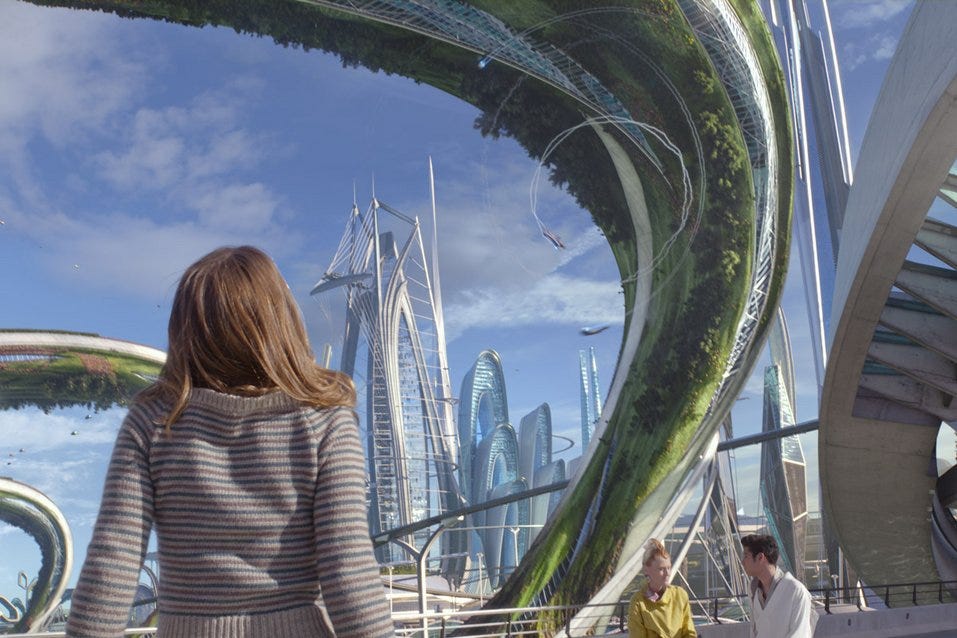
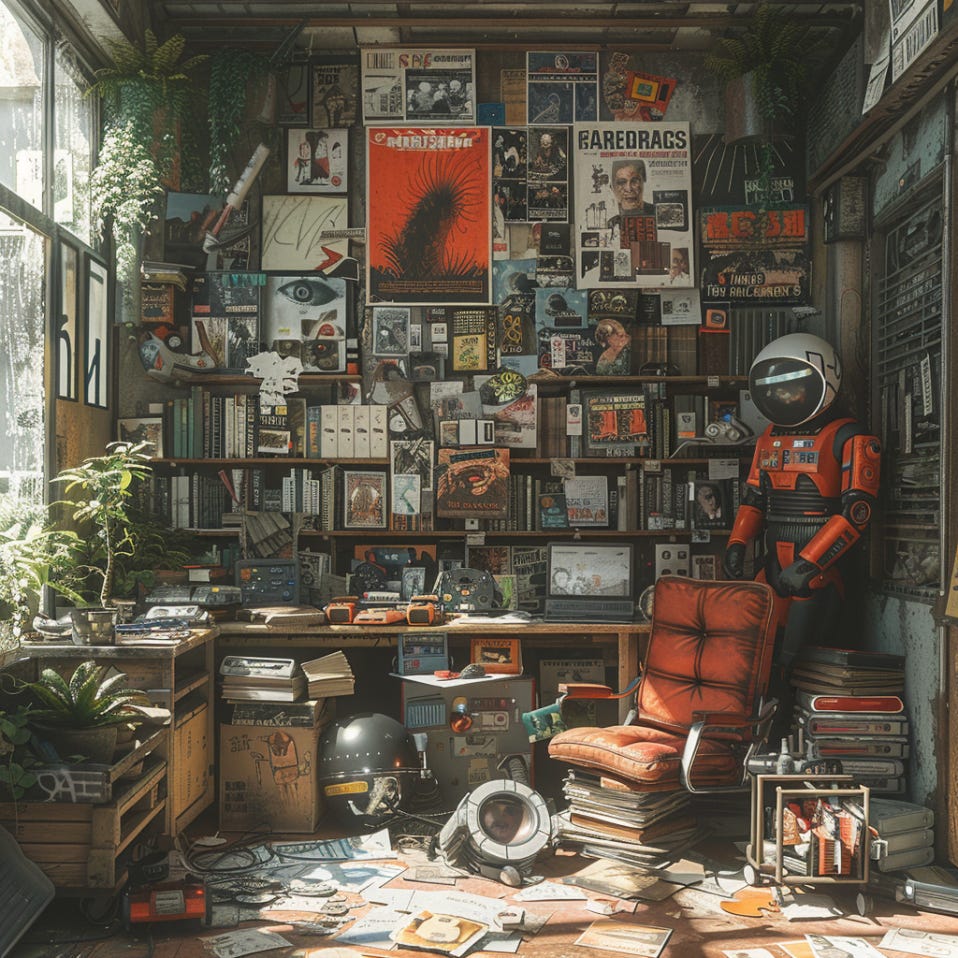
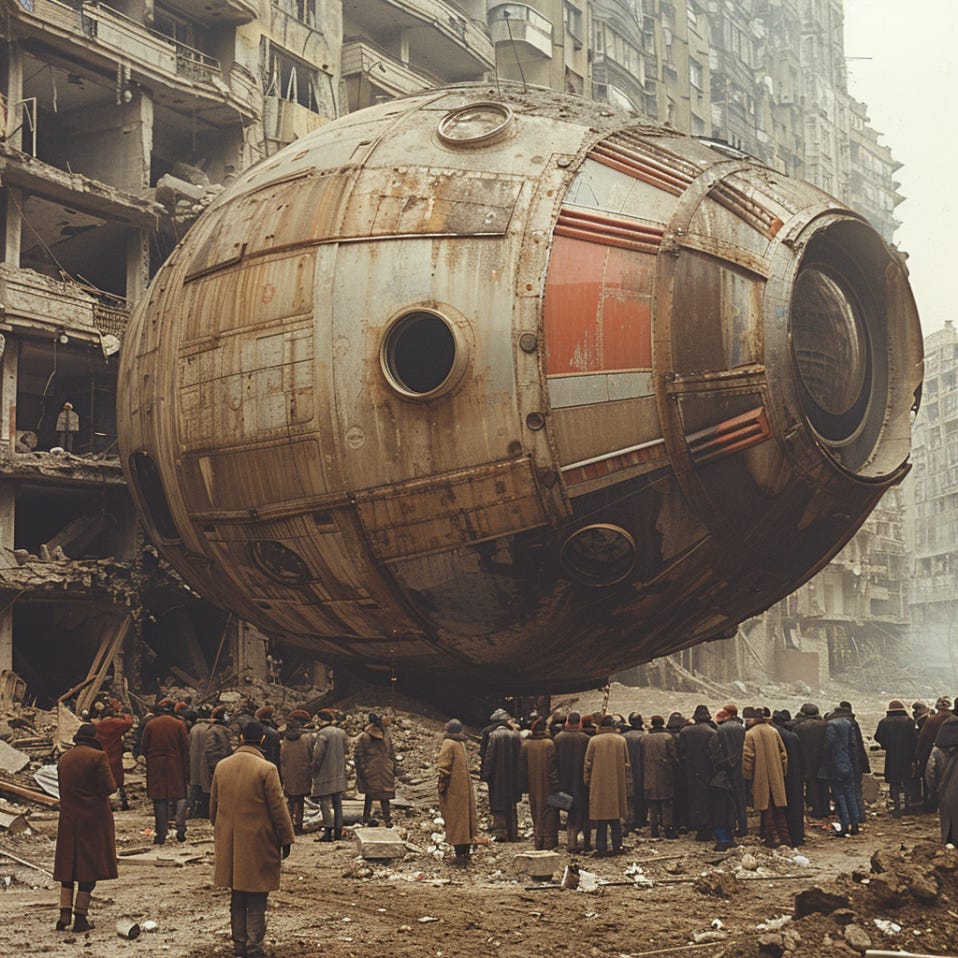


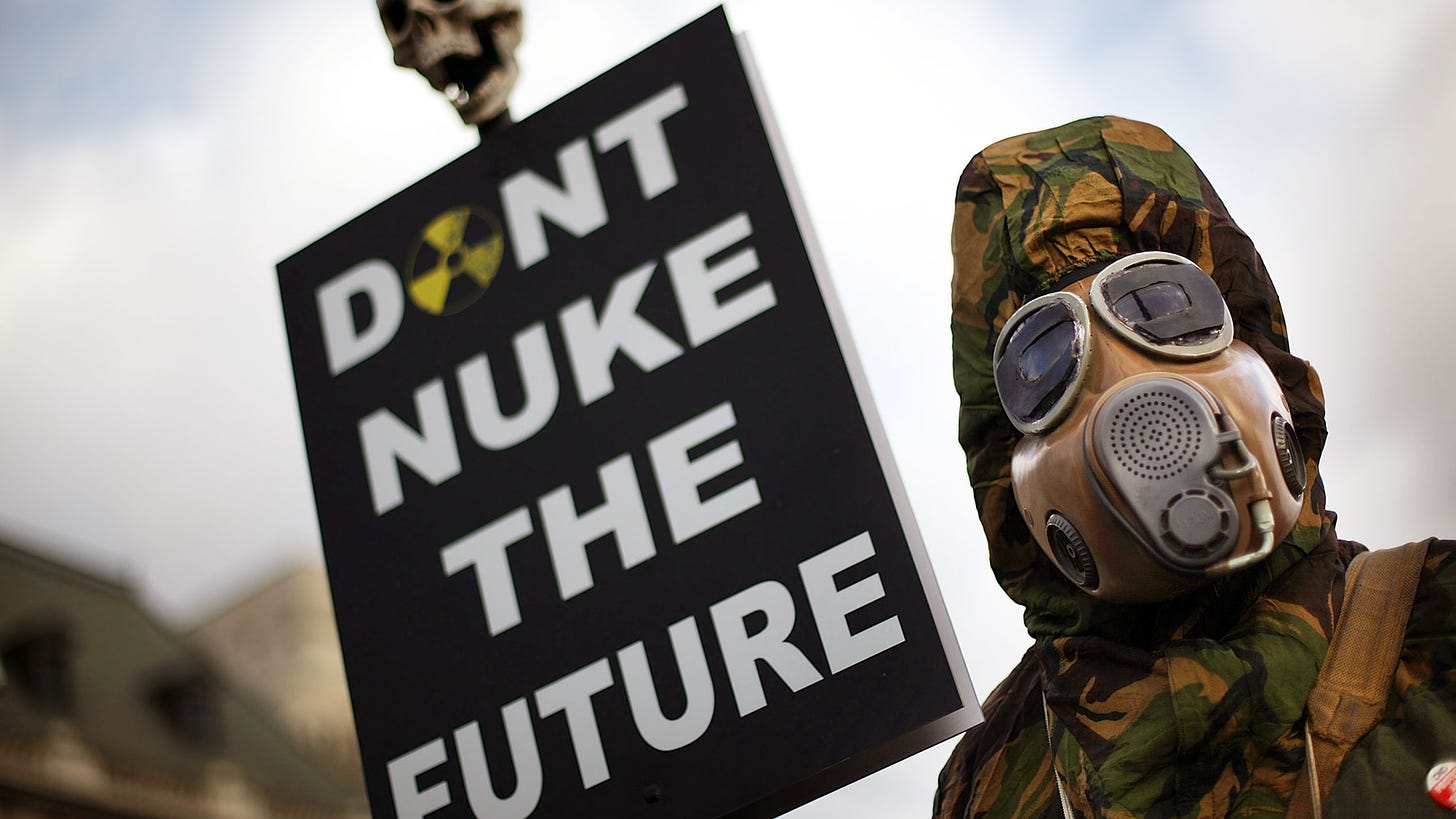
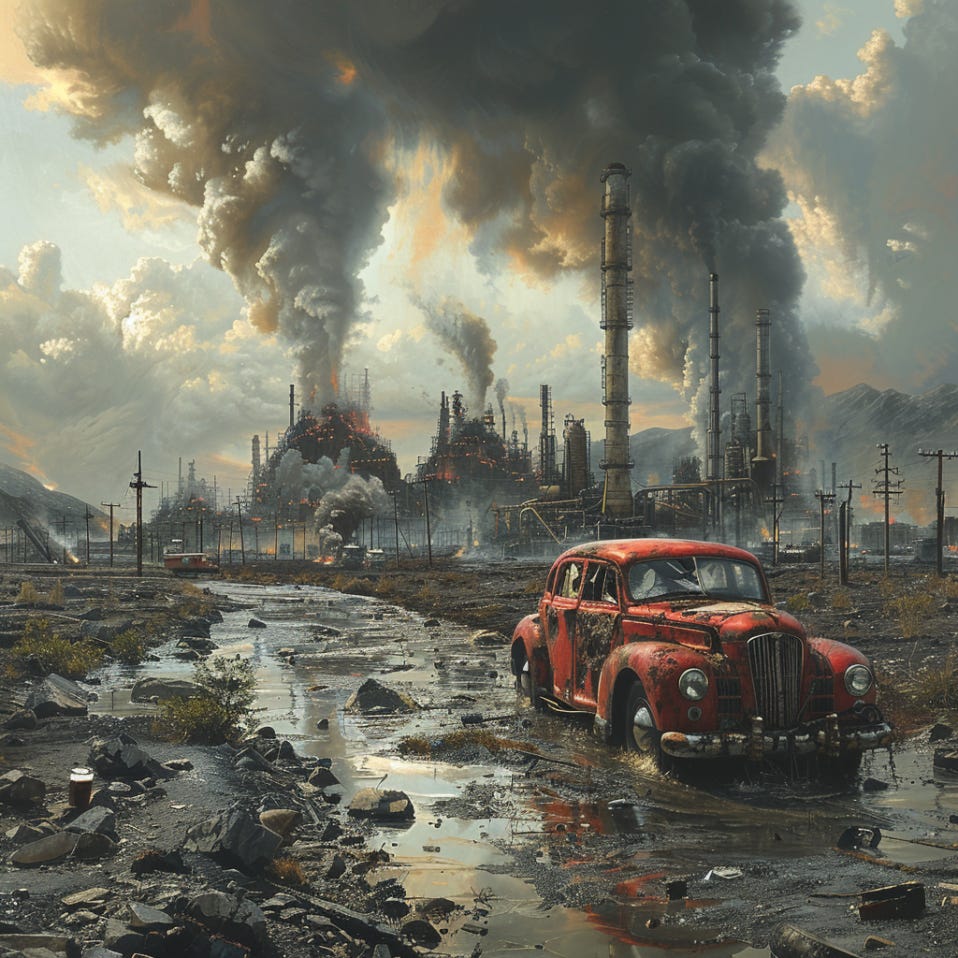
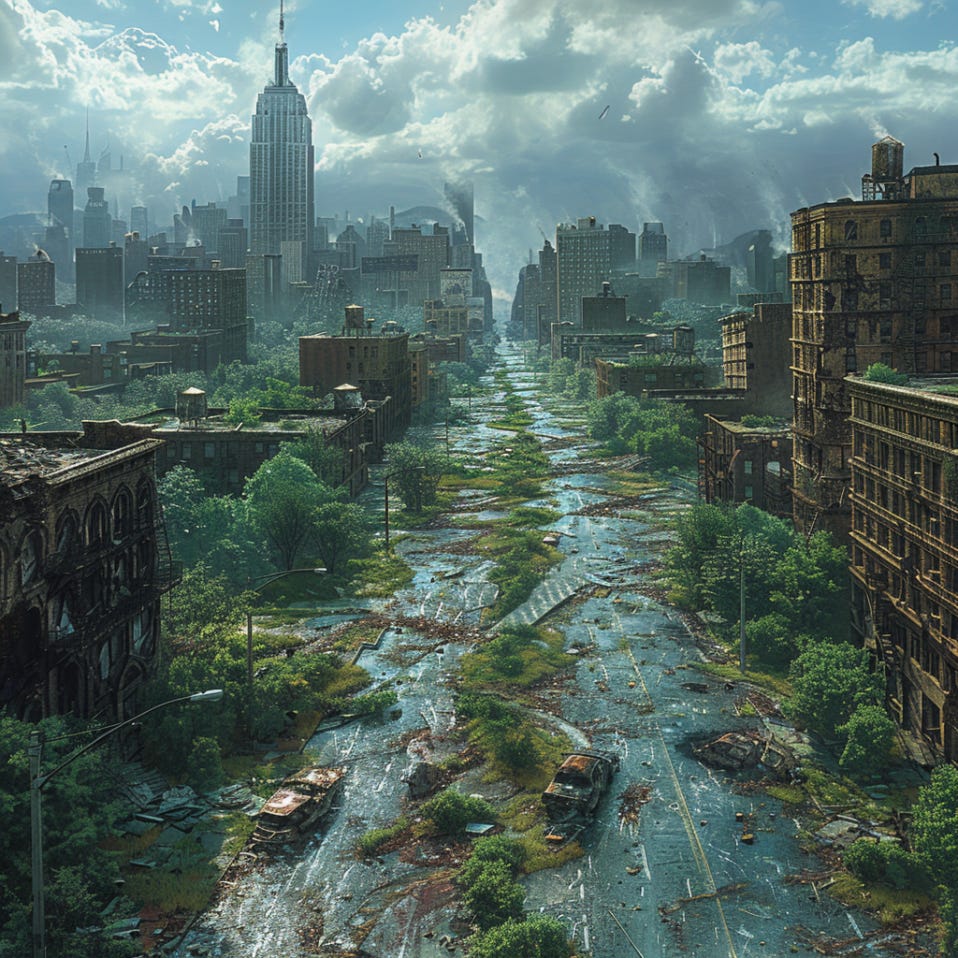
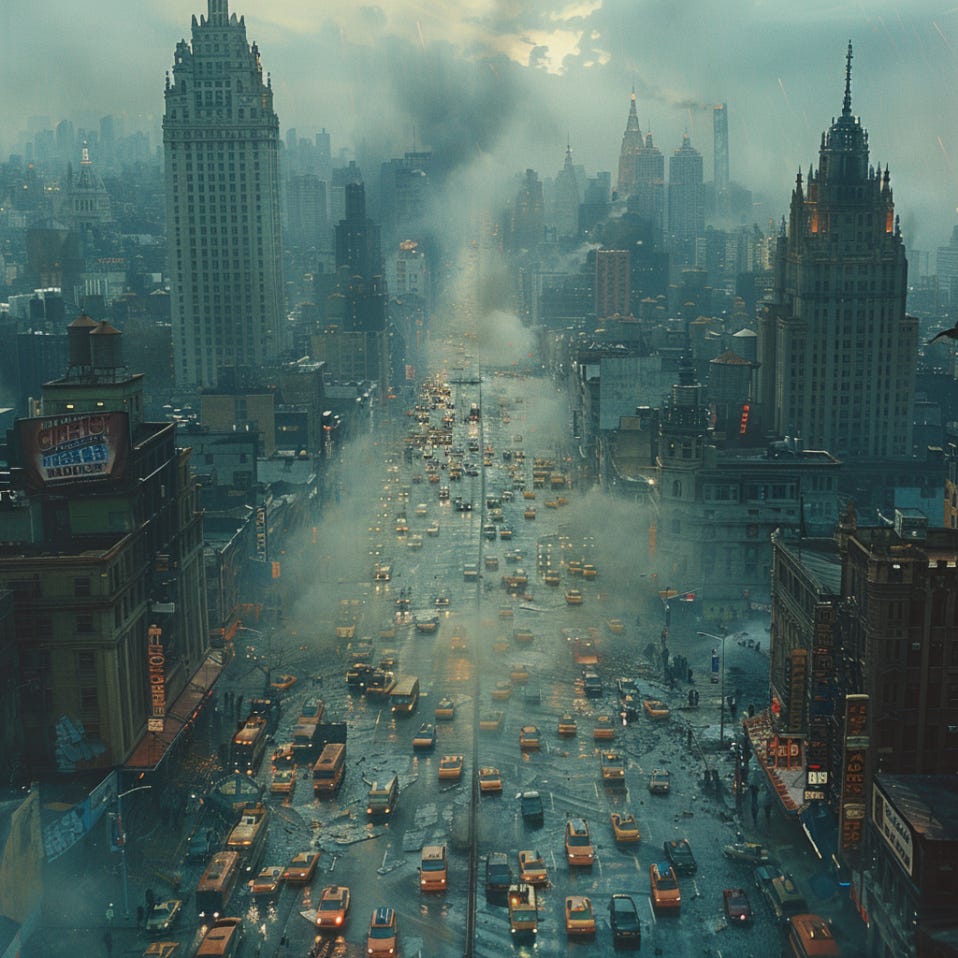

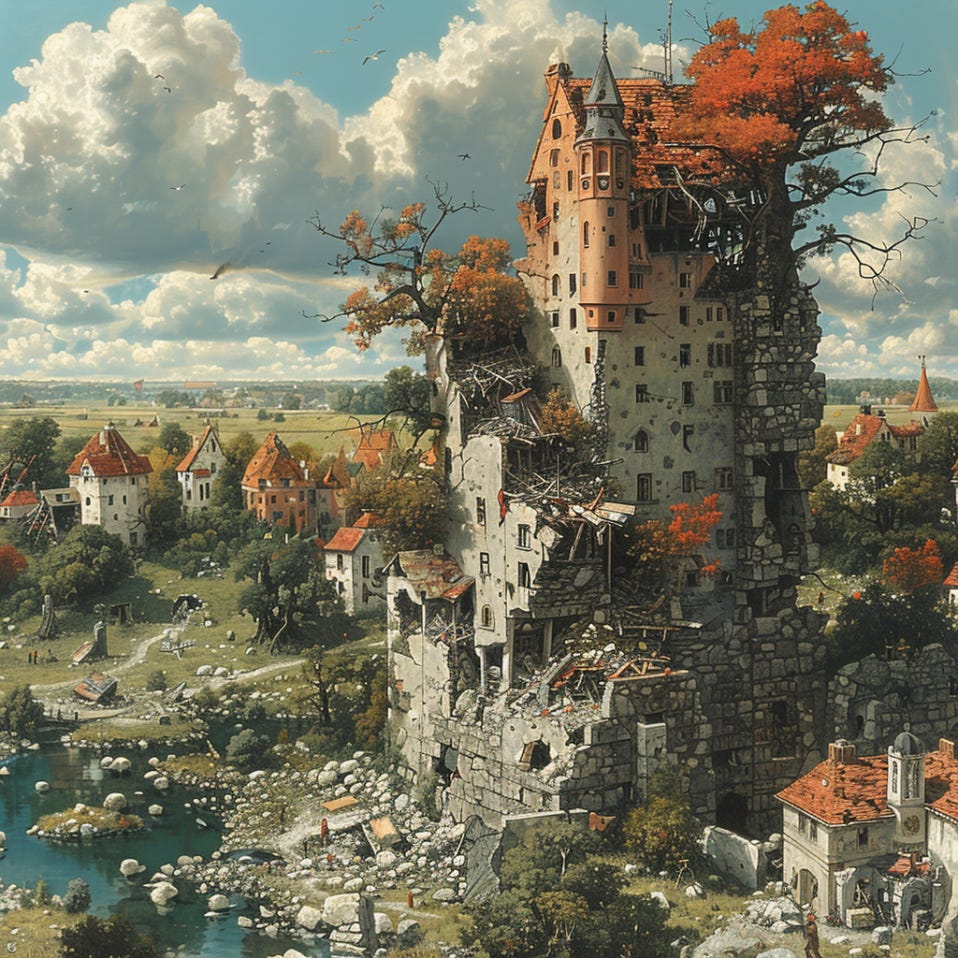
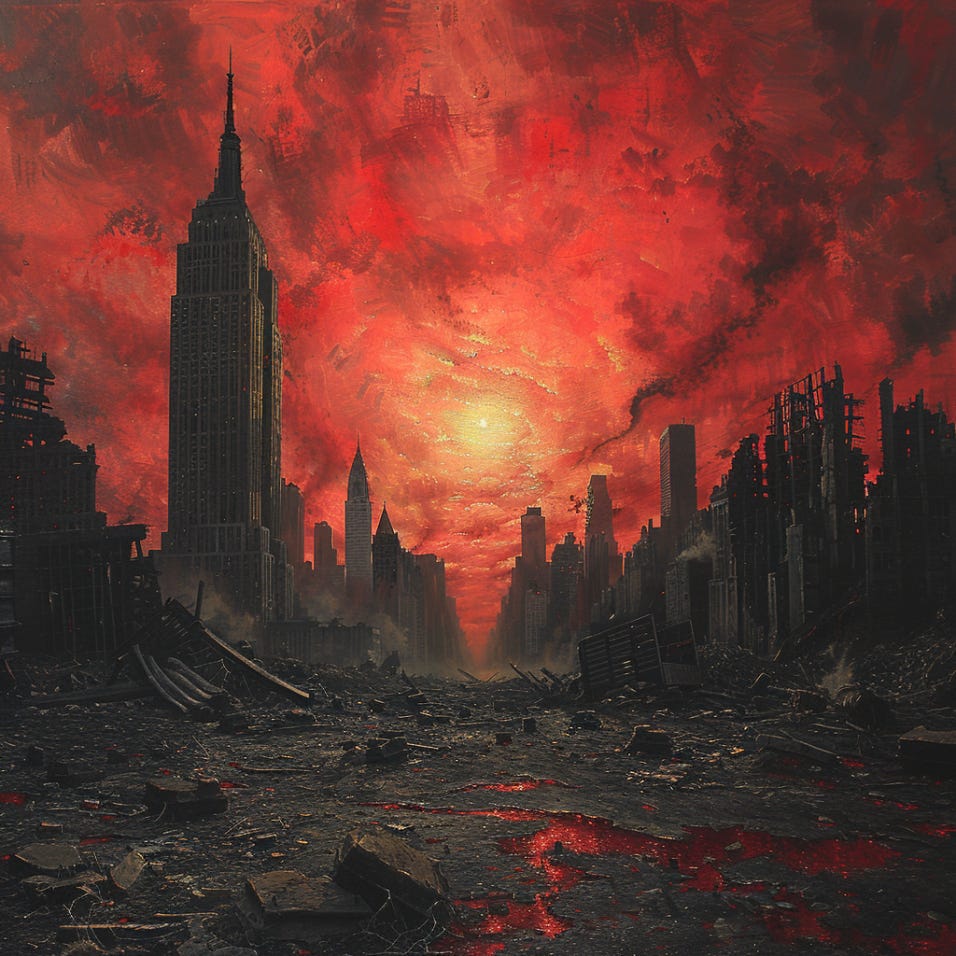

Frank Wright- the Hobbit of Hate, Frank Wrong - Sensible Maximalist, Frank "Not" Wright, but NEVER "Sir". Thank you for the "Mister", Qais.
Have you read Archeofuturism?